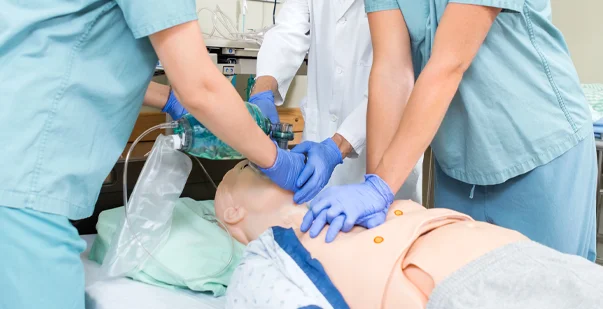Table of Content(s)
- Effective Team Dynamics in CPR & BLS: An Introduction
- What are the examples of effective team dynamics BLS/CPR
- Technology and Tools to Enhance Team Performance
- Conclusion
Emergencies can strike anytime and anywhere. When an individual suffers cardiac arrest or other life threatening problems, every second counts. The difference between life and death in such scenarios truly depend on the effectiveness of the response team. Effective team dynamics in CPR and BLS isn’t just beneficial; it is critical. Effective emergency response in the event of cardiac arrest is always associated with higher survival rates. The ability of a team to communicate seamlessly in chaotic situations, dramatically impact patient outcomes.
In today’s blog we will highlight the elements that contribute to effective team dynamics. From the importance of clear leadership and defined roles to the instances of communication under pressure, we will provide actionable insights and strategies to help you and your team perform at your best.
What are the examples of effective team dynamics BLS/CPR
Effective team dynamics in Basic Life Support scenarios is about ensuring quick and coordinated action. In high pressure environments, team members must be aware of their distinctive role and responsibility. Here are the key examples of effective team dynamics in BLS:
Clear Leadership and Role Assignment:
- Scenario: A patient collapses in a public place.
- Dynamic: The most experienced team member takes charge, quickly assigning specific tasks such as chest compressions, ventilation, and AED operation.
- Outcome: Each team member knows their role, leading to efficient and uninterrupted patient care.
Effective Communication:
- Scenario: During an intervention, a team member notices the patient’s condition changing.
- Dynamic: The team member clearly and concisely communicates the change to the leader and other team members.
- Outcome: The team adjusts their actions promptly, ensuring that the patient receives the most appropriate care.
Anticipation and Readiness:
- Scenario: A patient in a hospital setting goes into cardiac arrest.
- Dynamic: Team members anticipate the need for certain equipment and medications, preparing them in advance.
- Outcome: There are no delays in delivering critical interventions, enhancing the chances of patient survival.
Mutual Support and Backup:
- Scenario: One team member becomes fatigued while performing chest compressions.
- Dynamic: Another team member steps in to take over compressions without hesitation, ensuring continuous and effective compressions.
- Outcome: The patient receives uninterrupted high-quality CPR, improving the likelihood of a positive outcome.
Debriefing and Continuous Improvement:
- Scenario: After an emergency, the team gathers to discuss what went well and what could be improved.
- Dynamic: Team members provide constructive feedback and share their perspectives on the intervention.
- Outcome: The team learns from the experience, enhancing their performance in future BLS or CPR scenarios.
Read More: The Ultimate Guide to CPR Certification for Non-Medical Professionals.
Technology and Tools to Enhance Team Performance
In CPR or BLS emergencies, the integration of technology can make a significant difference. These advancements provide the team with resources that enhance communication and collaboration. This ultimately improves the overall quality of patient care. Let’s see how technology and tools can be utilized to enhance team performance in BLS and CPR:
Automated External Defibrillators (AEDs):
- Benefit: AEDs are designed to be user-friendly and provide clear, step-by-step instructions.
- Impact: Ensures that even team members with minimal training can deliver effective defibrillation, increasing the chances of patient survival.
Real-Time Feedback Devices:
- Benefit: Devices such as CPR manikins with built-in feedback mechanisms provide instant information on compression depth, rate, and recoil.
- Impact: Enhances the quality of CPR by allowing team members to adjust their techniques in real-time.
Communication Apps and Devices:
- Benefit: Secure messaging apps and dedicated communication devices facilitate seamless information exchange among team members.
- Impact: Improves coordination and ensures that critical updates are relayed quickly and accurately.
Simulation and Virtual Reality Training:
- Benefit: High-fidelity simulators and VR environments create realistic training scenarios for team practice.
- Impact: Prepares teams for real-life emergencies by enhancing their skills and fostering team cohesion in a controlled, risk-free setting.
Mobile Health Applications:
- Benefit: Apps provide quick access to protocols, guidelines, and drug information.
- Impact: Supports decision-making and ensures that team members can reference vital information during an emergency.
Team Performance Analytics:
- Benefit: Data collected from training sessions and real-life interventions can be analyzed to identify areas for improvement.
- Impact: Helps teams understand their strengths and weaknesses, leading to targeted training and better overall performance.
Smart Wearables and Monitoring Devices:
- Benefit: Wearable technology monitors the health and stress levels of team members.
- Impact: Ensures that team members remain in optimal condition to perform, reducing the risk of errors due to fatigue or stress.
Read More: Implications of CPR: Can You Get Sued for Performing CPR?
Conclusion
Effective team dynamics in CPR & BLS ensures the success of the entire operation. From clarity in positions to precise coordination, each element of team dynamics stands crucial and indispensable. With the ever evolving landscape of emergency medical response, strategies and tools used in CPR and BLS interventions should develop as well. Remember, the goal is to create a well coordinated, cohesive team that makes life easy in situations of emergency and crisis.
